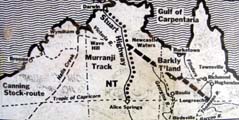Roper Bar's European History |
|
While Abel Tasman named the Limmen Bight, Cape Maria and Arnhem Land in 1644,
Willem Joosten van Colster had already sailed into the Gulf of Carpentaria
in 1606. Pastoralism began in Roper Bar in 1883, but the cattle industry
was limited by poor grazing, resistance from Aboriginal people
and an embargo on Territory cattle due to Red Water Fever. A landing and depot site were erected in Roper Bar in 1871 to bring
in supplies for the over 300 men of the construction teams on
the northern section of the overland telegraph line form Port
Darwin to Port Augusta in South Australia. D'Arcy W. Uhr and brother Matthew Dillon Cox drove 400 head
of cattle to the Roper in 1872. With the overlanders came a sly grog shop run by Black Jack
Reid, who sailed on the vessel "Good Intent". The overlanders left fellow drovers who died through misadventure
behind. A township on the Roper, Urapungai, was also planned as a
major town but failed even before a building was erected. With war on our doorstep, the North Australia Observer Unit
set up a headquarter at Roper Bar in 1942.
|
|
No liability for timeliness, integrity and correctness of this document is accepted. |
|
|


